Machine Learning algorithms in Chess game
Download as PPTX, PDF0 likes70 views
Using machine learning algorithms to optimize board game like chess and find best moves
1 of 20
Download to read offline

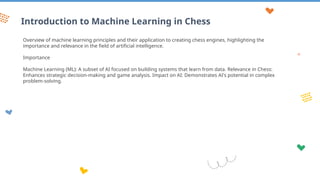
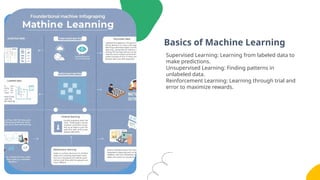
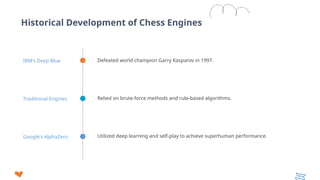
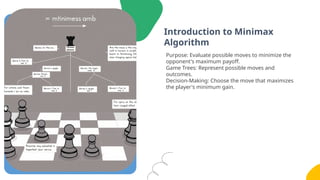
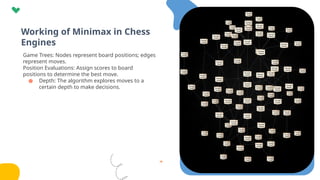
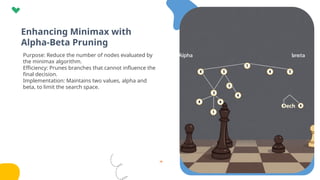
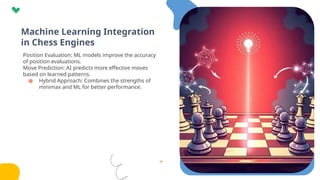
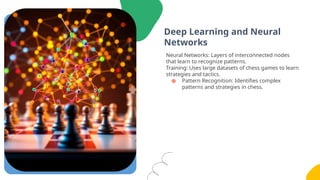
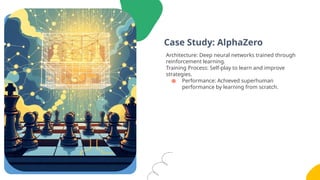
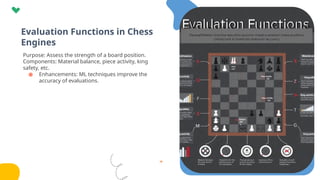
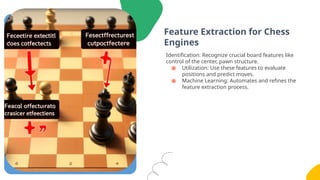
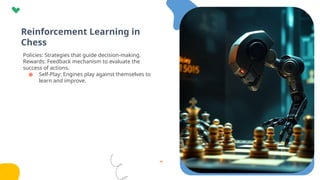
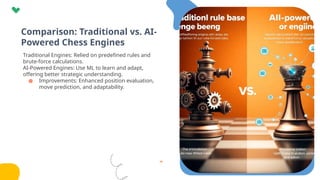
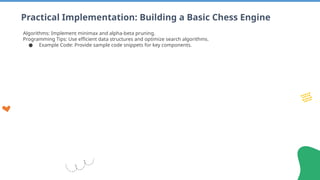
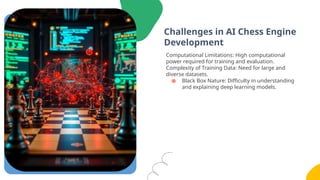
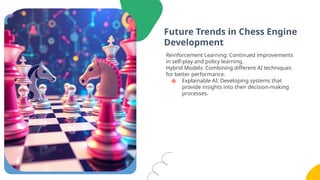
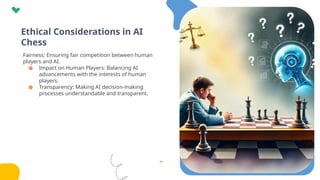
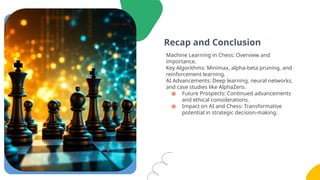
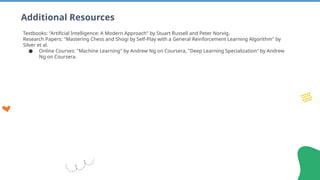
Recommended
charan ts.pptx it is just a ppt which is useful for ppt



charan ts.pptx it is just a ppt which is useful for pptsrinathbadugu7070
╠²
This is a sample ppt to create the technical seminarCrafting Interactive Experiences Through Game Programming.pptx



Crafting Interactive Experiences Through Game Programming.pptxshilpamathur13
╠²
In the rapidly evolving landscape of technology, machine learning and artificial intelligence (AI) are reshaping various industries, including video game development. Understanding the integration of these advanced technologies with game programming offers insights into how modern games are crafted to provide immersive and personalized experiences. This comprehensive guide will delve into the core principles of machine learning, its applications in game development, and the importance of game programming in designing interactive experiences. It will also explore the differences between traditional rule-based AI and machine learning-based AI in games, the role of popular game development engines like Unity, and the ethical considerations surrounding AI, especially in the context of bias.IPL Match winning prediction using machine learning



IPL Match winning prediction using machine learningprasadmaruthi272
╠²
This ppt is on IPl match winning prediction using machine learningMachine Learning for Game Artificial Intelligence.pptx



Machine Learning for Game Artificial Intelligence.pptxshilpamathur13
╠²
The intersection of machine learning, game programming, and AI has transformed the video game industry, enabling the creation of more dynamic, engaging, and personalized experiences. This summary explores the foundational principles of machine learning, its application in game development, and the technological advancements that power modern video games. Additionally, it delves into the ethical implications of AI in games, particularly regarding bias, and the various machine learning techniques that enhance game AI and player experiences.Machine Learning Contents.pptx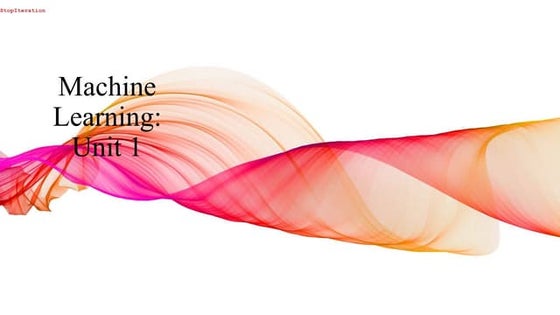



Machine Learning Contents.pptxNaveenkushwaha18
╠²
1. The document discusses machine learning types including supervised learning, unsupervised learning, and reinforcement learning. It provides examples of applications like spam filtering, recommendations, and fraud detection.
2. Key challenges in machine learning are discussed such as poor quality data, lack of training data, and imperfections when data grows.
3. The difference between data science and machine learning is explained - data science is a broader field that includes extracting insights from data using tools and models, while machine learning focuses specifically on making predictions using algorithms.Machine Learning course in Chandigarh Join



Machine Learning course in Chandigarh Joinasmeerana605
╠²
The machine learning process is iterative. Data collection and preparation are crucial. Feature engineering transforms raw data into meaningful representations. Model selection involves trying different algorithms. Training exposes the model to data and allows it to learn. We evaluate how well it performs on new data before finally deploying it for predictions.Join Machine Learning course in Chandigarh.Chess Engine



Chess Enginesleepy sleep
╠²
Chess Engine Presentation for Major Project. Contains Introductions, Objective, Methodology and other formalities with images and diagrams.Engineering Intelligent Systems using Machine Learning 



Engineering Intelligent Systems using Machine Learning Saurabh Kaushik
╠²
This document discusses machine learning and how to engineer intelligent systems. It begins with an overview of machine learning compared to traditional programming. Next, it explains why machine learning is significant due to its ability to automate complex tasks and adapt/learn. It then discusses what machine learning is, the process of building machine learning models including data preparation, algorithm selection, training and evaluation. Finally, it provides examples of machine learning applications and demos predicting customer churn using classification algorithms and evaluating model performance.Introduction to Machine Learning Key Concepts for Beginners.pptx



Introduction to Machine Learning Key Concepts for Beginners.pptxAssignment World
╠²
Machine Learning (ML) is a branch of artificial intelligence that enables computers to learn from data and make predictions or decisions without being explicitly programmed. This infographic explores key ML concepts, including supervised and unsupervised learning, algorithms like regression and classification, and essential steps in model building. Whether you're a beginner or looking to refine your understanding, this guide simplifies complex topics, making ML more accessible for students and professionals alike.Machine Learning: Techniques, Trends, and Transformative Applications - Nomidl



Machine Learning: Techniques, Trends, and Transformative Applications - NomidlNomidl Official
╠²
Machine Learning (ML) is a rapidly evolving field that has revolutionized the way we approach and solve complex problems across various domains. Building an ML model with zero code



Building an ML model with zero codeNick Trogh
╠²
This document discusses how to build machine learning models with zero lines of code using Microsoft's Azure Machine Learning service. It introduces domain-specific pretrained models, popular frameworks, productive services, and familiar data science tools available in Azure ML that can simplify and accelerate the model development process. It also demonstrates the visual interface and automated machine learning capabilities of Azure ML that allow users to build, test, and deploy models without writing code.Alpha go 16110226_Ļ╣ĆņśüņÜ░



Alpha go 16110226_Ļ╣ĆņśüņÜ░ņśüņÜ░ Ļ╣Ć
╠²
AlphaGo is a Go-playing program developed by DeepMind that uses a combination of Monte Carlo tree search and deep neural networks to defeat human professionals. It uses policy networks trained via supervised and reinforcement learning to guide the search by providing prior probabilities over moves, and value networks trained via reinforcement learning to evaluate board positions. By integrating neural network guidance into the tree search process, AlphaGo was able to defeat other Go programs and the European Go champion without relying solely on brute force search of the enormous game tree.Machine learning 11.pptx



Machine learning 11.pptxVishalKumar585848
╠²
This document provides an overview of machine learning. It defines machine learning as a branch of artificial intelligence that allows computers to learn from data without being explicitly programmed. It discusses the main types of machine learning: supervised learning, unsupervised learning, and reinforcement learning. It also outlines some popular machine learning algorithms and applications. Finally, it discusses the advantages and disadvantages of machine learning as well as its promising future and broad career opportunities.Introduction to Machine Learning



Introduction to Machine LearningData Works MD
╠²
Data Works MD September 2019 - https://www.meetup.com/DataWorks/events/264711404/
Video is available at https://www.youtube.com/watch?v=Y3b4Cnnilfw
Introduction to Machine Learning
Machine Learning continues itsŌĆÖ rise in the common day vernacular and is used anywhere from automating mundane tasks to offering intelligent insights across many industries. You may already be using a device that utilizes it. For example, a wearable fitness tracker like Fitbit, or an intelligent home assistant like Google Home. But there are much more examples of ML in use.
ŌĆó Predictive Analysis
ŌĆó Image recognition
ŌĆó Speech Recognition
ŌĆó Medical diagnoses
ŌĆó Cyber Security
This session will cover an introduction to Machine Learning to include data modeling, supervised/ unsupervised learning and visualizations.
Stephen Scarbrough, CISSP, C|EH
Joined the US Navy in 1990 and retired after 20 years as a CTNC(SW/AW/NAC). Early career was as Tactical Communications operator onboard surface ships and aircraft. Begin Network Administration and Network Security in late1998. In 2005,
Joined the NSA/CSS Red/Blue Team for several years. In 2010 I retired and joined IntelliGenesis LLC in which I am a Senior SIGINT Development Analyst and currently the lead contractor for the National Cryptologic Schools DATA Curriculum, which include Data Science and Advanced Analytics Tradecraft mentoring.Lecture-6-7.pptx



Lecture-6-7.pptxJohnMichaelPadernill
╠²
1. Machine learning is the use and development of computer systems that are able to learn and adapt without explicit instructions by using algorithms and statistical models to analyze patterns in data.
2. The document provides examples of machine learning applications like facial recognition, voice recognition in healthcare, weather forecasting, and more. It also discusses the process of machine learning and popular machine learning algorithms.
3. The document demonstrates machine learning using a decision tree algorithm on music purchase data to predict whether a customer is male or female based on attributes like age and number of songs purchased. It imports relevant Python libraries and splits the data into training and test sets to evaluate the model's performance.INTRODUCTIONTOML2024 for graphic era.pptx



INTRODUCTIONTOML2024 for graphic era.pptxchirag19saxena2001
╠²
Creating a detailed 4000-word introduction for a PowerPoint presentation named "INTRODUCTIONTOML2024 for Graphic Era.pptx" would require an in-depth understanding of the specific content, objectives, and context of the presentation. Since I can't access the content of external files like PowerPoint presentations, I'll provide a general approach you can take to create such an introduction:
Title: Introduction to ML 2024 - A Path Towards Innovation
1. Overview of ML 2024 Presentation:
Briefly introduce the purpose and scope of the presentation.
Highlight the importance of Machine Learning (ML) in driving innovation and advancements in various fields.
2. Evolution of Machine Learning:
Trace the evolution of ML from its early roots to its current state.
Discuss key milestones, breakthroughs, and advancements that have shaped the field.
3. Importance of Machine Learning in the 21st Century:
Explore the significance of ML in addressing complex challenges and driving technological progress.
Discuss real-world applications of ML across industries such as healthcare, finance, transportation, and entertainment.
4. ML Trends and Predictions for 2024:
Provide insights into the current trends and emerging technologies in ML.
Discuss predictions for the future of ML in 2024, including advancements in deep learning, reinforcement learning, and natural language processing.
5. Role of Graphic Era University in Advancing ML:
Highlight the contributions of Graphic Era University in the field of ML.
Showcase research initiatives, collaborations, and academic programs focused on ML at the university.
6. Objectives of the Presentation:
Define the specific objectives and goals of the ML 2024 presentation.
Outline the key topics, themes, and discussions that will be covered.
7. Target Audience:
Identify the target audience for the presentation, including students, faculty, industry professionals, and researchers.
Tailor the content and delivery approach to meet the needs and interests of the audience.
8. Structure of the Presentation:
Provide an overview of the structure and organization of the presentation.
Outline the sequence of topics, sections, and slides that will be covered.
9. Conclusion:
Summarize the key points discussed in the introduction.
Emphasize the significance of ML in driving innovation and shaping the future.
Invite the audience to engage with the presentation and participate in discussions.
10. References and Further Reading:
Provide a list of references, resources, and recommended reading materials for those interested in learning more about ML.
By following this structured approach, you can create a comprehensive introduction for the ML 2024 presentation, setting the stage for an engaging and informative discussion on the latest trends and developments in the field of Machine Learning.
Machine Learning for Crypo-Assets



Machine Learning for Crypo-Assetsintotheblock
╠²
This document discusses using machine learning for analyzing crypto assets. It begins with an introduction to machine learning and the differences between machine learning and statistics. It then discusses using machine learning for scenarios like blockchain deanonymization, investor profiling, factor identification, and price predictions. For each scenario, it provides an example machine learning model and the potential results. The document also discusses challenges for crypto data like lack of labeled datasets and introduces techniques like semi-supervised learning, transfer learning and neural architecture search that are relevant for crypto machine learning.Game Playing in Artificial intelligence.pptx



Game Playing in Artificial intelligence.pptxurvashipundir04
╠²
Game Playing in Artificial intelligence.pptxHuman in the loop: Bayesian Rules Enabling Explainable AI



Human in the loop: Bayesian Rules Enabling Explainable AIPramit Choudhary
╠²
The document provides an overview of a presentation on enabling explainable artificial intelligence through Bayesian rule lists. Some key points:
- The presentation will cover challenges with model opacity, defining interpretability, and how Bayesian rule lists can be used to build naturally interpretable models through rule extraction.
- Bayesian rule lists work well for tabular datasets and generate human-understandable "if-then-else" rules. They aim to optimize over pre-mined frequent patterns to construct an ordered set of conditional statements.
- There is often a tension between model performance and interpretability. Bayesian rule lists can achieve accuracy comparable to more opaque models like random forests on benchmark datasets while maintaining interpretability.Introduction To My Graduation Project



Introduction To My Graduation ProjectOmar Enayet
╠²
This slide show talks about my Graduation Project which is pending this year.My Graduation project will be around "Planning,Learning and Adaptation in Real-time Strategy Games".The Presentation consists of 2 main parts, one about the techniques used in game AI engines ,and the other about the latest research in Real-Time Strategy Games concerning learning and planning.My partner in this Project is AbdelRahman Al- Ogail.Machine Learning_Unit 2_Full.ppt.pdf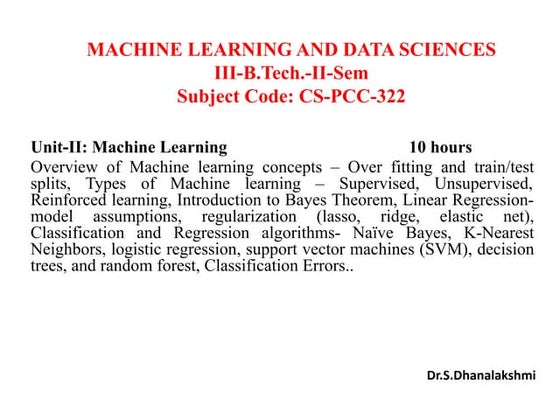



Machine Learning_Unit 2_Full.ppt.pdfDr.DHANALAKSHMI SENTHILKUMAR
╠²
This document provides an overview of machine learning concepts and techniques. It discusses supervised learning methods like classification and regression using algorithms such as naive Bayes, K-nearest neighbors, logistic regression, support vector machines, decision trees, and random forests. Unsupervised learning techniques like clustering and association are also covered. The document contrasts traditional programming with machine learning and describes typical machine learning processes like training, validation, testing, and parameter tuning. Common applications and examples of machine learning are also summarized.Getting Started with Azure AutoML



Getting Started with Azure AutoMLVivek Raja P S
╠²
The session is about creating, training, evaluating and deploying machine learning with no-code approach using Azure AutoML.
* NO MACHINE LEARNING EXPERIENCE REQUIRED *
Agenda:
1. Introduction to Machine Learning
2. What is AutoML (Automated Machine Learning) ?
3. AutoML versus Conventional ML practices
4. Intro to Azure Automated Machine Learning
5. Hands-on demo
6 Contest
6. Learning resources
7. ConclusionUnit 2 artificial intelligence and machine learning



Unit 2 artificial intelligence and machine learningAyushSingh695401
╠²
Artificial intelligence and machine learning are lpu presentation Breeding Methods in Flower Crops....pptx



Breeding Methods in Flower Crops....pptxAnkita Bharti Rai
╠²
With the increasing demand of ornamental crops worldwide, the commercialization of floricultural crops with wide range of variations in terms of colours, fragrances, shelf-life etc. is being carried out at international level.
The floricultural industry now demands new floral varieties with ease of transportation, increased shelf-life and easy cultivation so as to reduce the undesirable traits and to increase the commercial uses of flower crops.
Thus, the breeders and cultivators are now focusing on several Conventional and Modern Approaches to create new varieties in a sustainable way.
Aerospace_Quiz_Complete.pptx tehbuagiegige



Aerospace_Quiz_Complete.pptx tehbuagiegigeamuthesh6
╠²
An **Aerospace Quiz** is a structured set of questions designed to test knowledge and understanding of topics related to aerospace engineering, aviation, and space exploration. It can be used for educational purposes, competitions, or general knowledge enhancement.
### **Topics Covered in an Aerospace Quiz**
Aerospace quizzes can include a broad range of topics, including:
#### **1. Aerodynamics and Fluid Mechanics**
- Principles of lift, drag, thrust, and weight
- BernoulliŌĆÖs theorem and airflow over wings
- Boundary layers and turbulence
- Supersonic and hypersonic flow
#### **2. Aircraft Structures and Materials**
- Types of aircraft structures (monocoque, semi-monocoque, truss)
- Aerospace materials (aluminum alloys, composites, titanium)
- Stress and strain analysis in aircraft design
#### **3. Propulsion Systems**
- Types of aircraft engines (turbojet, turbofan, turboprop, piston engines)
- Rocket propulsion principles
- Jet engine components and their functions
#### **4. Avionics and Control Systems**
- Flight control surfaces (ailerons, elevators, rudders)
- Instrumentation and navigation systems
- Autopilot and fly-by-wire technology
#### **5. Spacecraft and Satellite Engineering**
- Orbital mechanics and KeplerŌĆÖs laws
- Types of satellites and their applications
- Space propulsion (ion thrusters, chemical rockets)
#### **6. Aerospace History and Milestones**
- Wright brothers' first flight
- Apollo missions and moon landings
- Development of supersonic and hypersonic aircraft
#### **7. Aerospace Companies and Innovations**
- NASA, SpaceX, Boeing, Airbus, Lockheed Martin
- Commercial space tourism and reusable rockets
- Future of aerospace (electric planes, Mars missions)
### **Types of Questions in an Aerospace Quiz**
Aerospace quizzes can include different types of questions, such as:
- **Multiple Choice Questions (MCQs):**
*Example:* What is the primary function of an aircraftŌĆÖs rudder?
a) Control pitch
b) Control yaw
c) Control roll
d) Reduce drag
*(Correct Answer: b) Control yaw)*
- **True or False:**
*Example:* The speed of sound is higher at higher altitudes. *(False, because air density decreases, reducing the speed of sound.)*
- **Fill in the Blanks:**
*Example:* The first human to walk on the Moon was _____. *(Answer: Neil Armstrong)*
- **Descriptive Questions:**
*Example:* Explain the working principle of a turbofan engine.
### **Why Take an Aerospace Quiz?**
- **Educational Value:** Helps reinforce key aerospace concepts.
- **Skill Assessment:** Tests knowledge of aviation and space technology.
- **Career Preparation:** Useful for students pursuing aerospace engineering or pilot training.
- **Fun and Engaging:** Encourages learning through a competitive and interactive approach.
Would you like me to create a set of aerospace quiz questions for you? ¤ÜĆMore Related Content
Similar to Machine Learning algorithms in Chess game (20)
Chess Engine



Chess Enginesleepy sleep
╠²
Chess Engine Presentation for Major Project. Contains Introductions, Objective, Methodology and other formalities with images and diagrams.Engineering Intelligent Systems using Machine Learning 



Engineering Intelligent Systems using Machine Learning Saurabh Kaushik
╠²
This document discusses machine learning and how to engineer intelligent systems. It begins with an overview of machine learning compared to traditional programming. Next, it explains why machine learning is significant due to its ability to automate complex tasks and adapt/learn. It then discusses what machine learning is, the process of building machine learning models including data preparation, algorithm selection, training and evaluation. Finally, it provides examples of machine learning applications and demos predicting customer churn using classification algorithms and evaluating model performance.Introduction to Machine Learning Key Concepts for Beginners.pptx



Introduction to Machine Learning Key Concepts for Beginners.pptxAssignment World
╠²
Machine Learning (ML) is a branch of artificial intelligence that enables computers to learn from data and make predictions or decisions without being explicitly programmed. This infographic explores key ML concepts, including supervised and unsupervised learning, algorithms like regression and classification, and essential steps in model building. Whether you're a beginner or looking to refine your understanding, this guide simplifies complex topics, making ML more accessible for students and professionals alike.Machine Learning: Techniques, Trends, and Transformative Applications - Nomidl



Machine Learning: Techniques, Trends, and Transformative Applications - NomidlNomidl Official
╠²
Machine Learning (ML) is a rapidly evolving field that has revolutionized the way we approach and solve complex problems across various domains. Building an ML model with zero code



Building an ML model with zero codeNick Trogh
╠²
This document discusses how to build machine learning models with zero lines of code using Microsoft's Azure Machine Learning service. It introduces domain-specific pretrained models, popular frameworks, productive services, and familiar data science tools available in Azure ML that can simplify and accelerate the model development process. It also demonstrates the visual interface and automated machine learning capabilities of Azure ML that allow users to build, test, and deploy models without writing code.Alpha go 16110226_Ļ╣ĆņśüņÜ░



Alpha go 16110226_Ļ╣ĆņśüņÜ░ņśüņÜ░ Ļ╣Ć
╠²
AlphaGo is a Go-playing program developed by DeepMind that uses a combination of Monte Carlo tree search and deep neural networks to defeat human professionals. It uses policy networks trained via supervised and reinforcement learning to guide the search by providing prior probabilities over moves, and value networks trained via reinforcement learning to evaluate board positions. By integrating neural network guidance into the tree search process, AlphaGo was able to defeat other Go programs and the European Go champion without relying solely on brute force search of the enormous game tree.Machine learning 11.pptx



Machine learning 11.pptxVishalKumar585848
╠²
This document provides an overview of machine learning. It defines machine learning as a branch of artificial intelligence that allows computers to learn from data without being explicitly programmed. It discusses the main types of machine learning: supervised learning, unsupervised learning, and reinforcement learning. It also outlines some popular machine learning algorithms and applications. Finally, it discusses the advantages and disadvantages of machine learning as well as its promising future and broad career opportunities.Introduction to Machine Learning



Introduction to Machine LearningData Works MD
╠²
Data Works MD September 2019 - https://www.meetup.com/DataWorks/events/264711404/
Video is available at https://www.youtube.com/watch?v=Y3b4Cnnilfw
Introduction to Machine Learning
Machine Learning continues itsŌĆÖ rise in the common day vernacular and is used anywhere from automating mundane tasks to offering intelligent insights across many industries. You may already be using a device that utilizes it. For example, a wearable fitness tracker like Fitbit, or an intelligent home assistant like Google Home. But there are much more examples of ML in use.
ŌĆó Predictive Analysis
ŌĆó Image recognition
ŌĆó Speech Recognition
ŌĆó Medical diagnoses
ŌĆó Cyber Security
This session will cover an introduction to Machine Learning to include data modeling, supervised/ unsupervised learning and visualizations.
Stephen Scarbrough, CISSP, C|EH
Joined the US Navy in 1990 and retired after 20 years as a CTNC(SW/AW/NAC). Early career was as Tactical Communications operator onboard surface ships and aircraft. Begin Network Administration and Network Security in late1998. In 2005,
Joined the NSA/CSS Red/Blue Team for several years. In 2010 I retired and joined IntelliGenesis LLC in which I am a Senior SIGINT Development Analyst and currently the lead contractor for the National Cryptologic Schools DATA Curriculum, which include Data Science and Advanced Analytics Tradecraft mentoring.Lecture-6-7.pptx



Lecture-6-7.pptxJohnMichaelPadernill
╠²
1. Machine learning is the use and development of computer systems that are able to learn and adapt without explicit instructions by using algorithms and statistical models to analyze patterns in data.
2. The document provides examples of machine learning applications like facial recognition, voice recognition in healthcare, weather forecasting, and more. It also discusses the process of machine learning and popular machine learning algorithms.
3. The document demonstrates machine learning using a decision tree algorithm on music purchase data to predict whether a customer is male or female based on attributes like age and number of songs purchased. It imports relevant Python libraries and splits the data into training and test sets to evaluate the model's performance.INTRODUCTIONTOML2024 for graphic era.pptx



INTRODUCTIONTOML2024 for graphic era.pptxchirag19saxena2001
╠²
Creating a detailed 4000-word introduction for a PowerPoint presentation named "INTRODUCTIONTOML2024 for Graphic Era.pptx" would require an in-depth understanding of the specific content, objectives, and context of the presentation. Since I can't access the content of external files like PowerPoint presentations, I'll provide a general approach you can take to create such an introduction:
Title: Introduction to ML 2024 - A Path Towards Innovation
1. Overview of ML 2024 Presentation:
Briefly introduce the purpose and scope of the presentation.
Highlight the importance of Machine Learning (ML) in driving innovation and advancements in various fields.
2. Evolution of Machine Learning:
Trace the evolution of ML from its early roots to its current state.
Discuss key milestones, breakthroughs, and advancements that have shaped the field.
3. Importance of Machine Learning in the 21st Century:
Explore the significance of ML in addressing complex challenges and driving technological progress.
Discuss real-world applications of ML across industries such as healthcare, finance, transportation, and entertainment.
4. ML Trends and Predictions for 2024:
Provide insights into the current trends and emerging technologies in ML.
Discuss predictions for the future of ML in 2024, including advancements in deep learning, reinforcement learning, and natural language processing.
5. Role of Graphic Era University in Advancing ML:
Highlight the contributions of Graphic Era University in the field of ML.
Showcase research initiatives, collaborations, and academic programs focused on ML at the university.
6. Objectives of the Presentation:
Define the specific objectives and goals of the ML 2024 presentation.
Outline the key topics, themes, and discussions that will be covered.
7. Target Audience:
Identify the target audience for the presentation, including students, faculty, industry professionals, and researchers.
Tailor the content and delivery approach to meet the needs and interests of the audience.
8. Structure of the Presentation:
Provide an overview of the structure and organization of the presentation.
Outline the sequence of topics, sections, and slides that will be covered.
9. Conclusion:
Summarize the key points discussed in the introduction.
Emphasize the significance of ML in driving innovation and shaping the future.
Invite the audience to engage with the presentation and participate in discussions.
10. References and Further Reading:
Provide a list of references, resources, and recommended reading materials for those interested in learning more about ML.
By following this structured approach, you can create a comprehensive introduction for the ML 2024 presentation, setting the stage for an engaging and informative discussion on the latest trends and developments in the field of Machine Learning.
Machine Learning for Crypo-Assets



Machine Learning for Crypo-Assetsintotheblock
╠²
This document discusses using machine learning for analyzing crypto assets. It begins with an introduction to machine learning and the differences between machine learning and statistics. It then discusses using machine learning for scenarios like blockchain deanonymization, investor profiling, factor identification, and price predictions. For each scenario, it provides an example machine learning model and the potential results. The document also discusses challenges for crypto data like lack of labeled datasets and introduces techniques like semi-supervised learning, transfer learning and neural architecture search that are relevant for crypto machine learning.Game Playing in Artificial intelligence.pptx



Game Playing in Artificial intelligence.pptxurvashipundir04
╠²
Game Playing in Artificial intelligence.pptxHuman in the loop: Bayesian Rules Enabling Explainable AI



Human in the loop: Bayesian Rules Enabling Explainable AIPramit Choudhary
╠²
The document provides an overview of a presentation on enabling explainable artificial intelligence through Bayesian rule lists. Some key points:
- The presentation will cover challenges with model opacity, defining interpretability, and how Bayesian rule lists can be used to build naturally interpretable models through rule extraction.
- Bayesian rule lists work well for tabular datasets and generate human-understandable "if-then-else" rules. They aim to optimize over pre-mined frequent patterns to construct an ordered set of conditional statements.
- There is often a tension between model performance and interpretability. Bayesian rule lists can achieve accuracy comparable to more opaque models like random forests on benchmark datasets while maintaining interpretability.Introduction To My Graduation Project



Introduction To My Graduation ProjectOmar Enayet
╠²
This slide show talks about my Graduation Project which is pending this year.My Graduation project will be around "Planning,Learning and Adaptation in Real-time Strategy Games".The Presentation consists of 2 main parts, one about the techniques used in game AI engines ,and the other about the latest research in Real-Time Strategy Games concerning learning and planning.My partner in this Project is AbdelRahman Al- Ogail.Machine Learning_Unit 2_Full.ppt.pdf



Machine Learning_Unit 2_Full.ppt.pdfDr.DHANALAKSHMI SENTHILKUMAR
╠²
This document provides an overview of machine learning concepts and techniques. It discusses supervised learning methods like classification and regression using algorithms such as naive Bayes, K-nearest neighbors, logistic regression, support vector machines, decision trees, and random forests. Unsupervised learning techniques like clustering and association are also covered. The document contrasts traditional programming with machine learning and describes typical machine learning processes like training, validation, testing, and parameter tuning. Common applications and examples of machine learning are also summarized.Getting Started with Azure AutoML



Getting Started with Azure AutoMLVivek Raja P S
╠²
The session is about creating, training, evaluating and deploying machine learning with no-code approach using Azure AutoML.
* NO MACHINE LEARNING EXPERIENCE REQUIRED *
Agenda:
1. Introduction to Machine Learning
2. What is AutoML (Automated Machine Learning) ?
3. AutoML versus Conventional ML practices
4. Intro to Azure Automated Machine Learning
5. Hands-on demo
6 Contest
6. Learning resources
7. ConclusionUnit 2 artificial intelligence and machine learning



Unit 2 artificial intelligence and machine learningAyushSingh695401
╠²
Artificial intelligence and machine learning are lpu presentation Recently uploaded (20)
Breeding Methods in Flower Crops....pptx



Breeding Methods in Flower Crops....pptxAnkita Bharti Rai
╠²
With the increasing demand of ornamental crops worldwide, the commercialization of floricultural crops with wide range of variations in terms of colours, fragrances, shelf-life etc. is being carried out at international level.
The floricultural industry now demands new floral varieties with ease of transportation, increased shelf-life and easy cultivation so as to reduce the undesirable traits and to increase the commercial uses of flower crops.
Thus, the breeders and cultivators are now focusing on several Conventional and Modern Approaches to create new varieties in a sustainable way.
Aerospace_Quiz_Complete.pptx tehbuagiegige



Aerospace_Quiz_Complete.pptx tehbuagiegigeamuthesh6
╠²
An **Aerospace Quiz** is a structured set of questions designed to test knowledge and understanding of topics related to aerospace engineering, aviation, and space exploration. It can be used for educational purposes, competitions, or general knowledge enhancement.
### **Topics Covered in an Aerospace Quiz**
Aerospace quizzes can include a broad range of topics, including:
#### **1. Aerodynamics and Fluid Mechanics**
- Principles of lift, drag, thrust, and weight
- BernoulliŌĆÖs theorem and airflow over wings
- Boundary layers and turbulence
- Supersonic and hypersonic flow
#### **2. Aircraft Structures and Materials**
- Types of aircraft structures (monocoque, semi-monocoque, truss)
- Aerospace materials (aluminum alloys, composites, titanium)
- Stress and strain analysis in aircraft design
#### **3. Propulsion Systems**
- Types of aircraft engines (turbojet, turbofan, turboprop, piston engines)
- Rocket propulsion principles
- Jet engine components and their functions
#### **4. Avionics and Control Systems**
- Flight control surfaces (ailerons, elevators, rudders)
- Instrumentation and navigation systems
- Autopilot and fly-by-wire technology
#### **5. Spacecraft and Satellite Engineering**
- Orbital mechanics and KeplerŌĆÖs laws
- Types of satellites and their applications
- Space propulsion (ion thrusters, chemical rockets)
#### **6. Aerospace History and Milestones**
- Wright brothers' first flight
- Apollo missions and moon landings
- Development of supersonic and hypersonic aircraft
#### **7. Aerospace Companies and Innovations**
- NASA, SpaceX, Boeing, Airbus, Lockheed Martin
- Commercial space tourism and reusable rockets
- Future of aerospace (electric planes, Mars missions)
### **Types of Questions in an Aerospace Quiz**
Aerospace quizzes can include different types of questions, such as:
- **Multiple Choice Questions (MCQs):**
*Example:* What is the primary function of an aircraftŌĆÖs rudder?
a) Control pitch
b) Control yaw
c) Control roll
d) Reduce drag
*(Correct Answer: b) Control yaw)*
- **True or False:**
*Example:* The speed of sound is higher at higher altitudes. *(False, because air density decreases, reducing the speed of sound.)*
- **Fill in the Blanks:**
*Example:* The first human to walk on the Moon was _____. *(Answer: Neil Armstrong)*
- **Descriptive Questions:**
*Example:* Explain the working principle of a turbofan engine.
### **Why Take an Aerospace Quiz?**
- **Educational Value:** Helps reinforce key aerospace concepts.
- **Skill Assessment:** Tests knowledge of aviation and space technology.
- **Career Preparation:** Useful for students pursuing aerospace engineering or pilot training.
- **Fun and Engaging:** Encourages learning through a competitive and interactive approach.
Would you like me to create a set of aerospace quiz questions for you? ¤ÜĆIntroduction of Cutaneous Nerves by M.Sundari Singh



Introduction of Cutaneous Nerves by M.Sundari Singhmeharsundarisingh
╠²
ASR HOMEOPATHIC MEDICAL COLLEGE
PRATHIPADU, TADEPALLIGUDEM
Explore the Museum of the Future in Dubai



Explore the Museum of the Future in DubaiDamac Cavalli Estates
╠²
Discover the Museum of the Future in Dubai, where cutting-edge technology meets visionary innovation. Explore immersive exhibits, AI advancements, and futuristic concepts that redefine possibilities. A must-visit destination for curious minds and tech enthusiasts.Basics of forensic chemical science.pptx



Basics of forensic chemical science.pptxkwasisafo36113
╠²
An introductory overview of the application of the principles and behavior of matter in Forensic ScienceImportance and Essentials and Necessities of Cell and Molecular Biology



Importance and Essentials and Necessities of Cell and Molecular Biologyjohnfreeguydoe
╠²
the comprehensive presentation about the introduction of Cell and Molecular biology EVOLUTION OF EUKARYOTIC CELLS AND ENDOSYMBIOSIS.pdf



EVOLUTION OF EUKARYOTIC CELLS AND ENDOSYMBIOSIS.pdfNistarini College, Purulia (W.B) India
╠²
Evolution is the call of the time irrespective of its nature, whether living or non-living. The abiotic entities gave birth to living ones in the passage of evolution. Prokaryotes came after a lot of hurdles. From prokaryotes, Eukaryotes evolved. There are lot of theories to explore the route bit the most convenient and acceptable one is the endosymbiotic theory. This presentation offers the origin of eukaryotic cells from the prokaryotic one through the long passage of evolution in the context of geological time scale.Igniting Progress: Outcomes from the FLARE workshop and three challenges for ...



Igniting Progress: Outcomes from the FLARE workshop and three challenges for ...Anne Barkley
╠²
Fire substantially influences and modulates the global carbon cycle through numerous processes, interactions, and feedbacks. Fires are strongly intertwined with human activities: people act both as drivers of change through ignitions, suppression, land-cover change, prescribed burning, and climate change, and are affected in return by changes in fire regimes. Despite fireŌĆÖs many complex interactions throughout the Earth System, it is often viewed only as a destructive process, and one that solely acts as a source of atmospheric carbon. In terms of fireŌĆÖs carbon budget, the release of carbon only represents the very initial stages of the process, missing the drivers and complex ways in which fire shapes plant species evolution and ecosystem trajectories, nutrient cycling and redistribution, carbon allocation, deposition and sequestration over different spatiotemporal scales. Therefore, there is a clear need to fully understand the role of fire in the Earth System holistically. However, different aspects of fireŌĆÖs role in the carbon cycle are often studied by different communities and disciplines, hindering this much-needed integrated understanding.
Through the Fire Learning AcRoss the Earth Systems (FLARE) workshop (September 2023) we brought together fire scientists across multiple disciplines to facilitate transdisciplinary discussion. We highlight a poor constraint on understanding the future impacts of fires on the Earth system, which stems from a lack of communication between relevant fields of expertise. In particular, a disconnect was identified between scientific approaches to understanding and characterising fire processes and the societal implications of fire events. We identify three main challenges that need to be addressed by the global fire community: unifying transdisciplinary research around common boundary objects, further understanding and quantifying the role of fire in the carbon cycle; better characterising fire and extreme events; and taking a holistic approach to understand fire interactions with humans.GNU Linux - Introduction and Administration.



GNU Linux - Introduction and Administration.Xavier de Pedro
╠²
║▌║▌▀Żs for the course on GNU Linux - Introduction and Administration. At UB Postgraduate course on Data Science. (2025 Edition).ASME BPVC Code Cases Section VIII 2023 Edition.pdf



ASME BPVC Code Cases Section VIII 2023 Edition.pdfmaud57
╠²
ASME BPVC Code Cases Section VIII 2023 EditionThe Sheena Bora Murder Case - Forensic Science.pptx



The Sheena Bora Murder Case - Forensic Science.pptxSahilShah140721
╠²
The presentation, "The Sheena Bora Murder Case: A Forensic Perspective," examines one of India's most sensational crimes, highlighting the crucial role of forensic science in solving the case. Sheena Bora, a 24-year-old woman, was allegedly murdered in 2012 by her mother, Indrani Mukerjea, but the crime remained undetected for three years due to police negligence and a well-planned cover-up. The case came to light in 2015 when IndraniŌĆÖs driver, Shyamvar Rai, was arrested in an unrelated case and confessed to the murder. Investigations revealed multiple motives, including financial disputes, personal conflicts, and IndraniŌĆÖs fear of exposure regarding her secret relationship with Sheena. Forensic science played a pivotal role, with DNA analysis confirming SheenaŌĆÖs identity, forensic anthropology determining strangulation as the cause of death, and digital forensics uncovering suspicious phone activity. Despite these breakthroughs, the case faced significant challenges such as mishandling of evidence, delayed forensic examinations, and prolonged legal proceedings. The investigation also raised ethical and psychological questions about family betrayals, financial greed, and the misuse of power. The ongoing trial, with Indrani Mukerjea granted bail in 2022, underscores the need for improved forensic infrastructure, better crime scene management, and a more efficient judicial process to ensure timely justice in such high-profile cases.Muscle Physiology A level Biology Powerpoint Edexcel A



Muscle Physiology A level Biology Powerpoint Edexcel Aridhimahindroo
╠²
Muscle contraction a level biology powerpointThe circulation of blood general anatomy by M.Sundari Singh



The circulation of blood general anatomy by M.Sundari Singhmeharsundarisingh
╠²
ASR Homeopathic Medical College
Prathipadu, Tadepalligudem
Mixing small molecules and macromolecules in the world of informatics



Mixing small molecules and macromolecules in the world of informaticsAlex Clark
╠²
Presentation at ACS Spring San Diego, 2025
Cheminformatics and bioinformatics have historically used different structure encoding strategies: small molecules are represented as atom/bond connection tables while large molecules use linear sequences of block mnemonics. The ever increasing relevance of non-natural building blocks and chemical functionalizations has driven demand for data formats such as HELM that can seamlessly represent both categories as part of the same molecular entity. For many use cases it is preferable to use a 2D format rather than linear notation in order to preserve layout information and facilitate more familiar and intuitive editing tools. We have revived a seemingly moribund feature in V3000 Molfiles called SCSR (self-contained sequence representation) which allows peptides, nucleotides, bases, sugars and other fragments to be defined in a separate section and referenced from the main connection table. This allows huge biopolymers to be represented concisely within the Molfile framework and be freely interspersed with structure fragments that are drawn out using conventional atom/bond drawing tools. The definitions of each block are stored inline which obviates the need for a global dictionary, and they can be formally converted to the correct all-atom structure suitable for molecular formula/weight, property calculations, substructure matches, conformational embedding for molecular dynamics, etc. We have been working with the Ketcher development team to build an open source editor that combines the existing 2D molecule sketcher with a new macromolecule editor. We will discuss the use of V3000 Molfiles for capturing mixed biochemical entities in the context of CDD Vault and open data use cases.Vaccines: types, preparations, efficacies and recent developments.pptx



Vaccines: types, preparations, efficacies and recent developments.pptxkrishna moorthy
╠²
Vaccines: types, preparations, efficacies and recent developmentsPolymerase-Chain-Reaction-PCR-Biotechnology.pptx



Polymerase-Chain-Reaction-PCR-Biotechnology.pptxvanshikag104
╠²
Polymerase Chain Reaction (PCR) is a powerful technique used to amplify specific DNA sequences, enabling rapid and precise genetic analysis. Developed by Kary Mullis in 1983, it involves three key steps: denaturation, annealing, and extension, using Taq polymerase to replicate DNA. PCR is widely used in medical diagnostics (COVID-19, HIV), forensic science (DNA fingerprinting), genetic research, and food safety (GMO detection). Variants like qPCR and RT-PCR enhance its applications in real-time analysis and RNA detection, making it an essential tool in biotechnology and molecular biology.Machine Learning algorithms in Chess game
- 2. Introduction to Machine Learning in Chess Overview of machine learning principles and their application to creating chess engines, highlighting the importance and relevance in the field of artificial intelligence. Importance Machine Learning (ML): A subset of AI focused on building systems that learn from data. Relevance in Chess: Enhances strategic decision-making and game analysis. Impact on AI: Demonstrates AI's potential in complex problem-solving.
- 3. Basics of Machine Learning Supervised Learning: Learning from labeled data to make predictions. Unsupervised Learning: Finding patterns in unlabeled data. Reinforcement Learning: Learning through trial and error to maximize rewards.
- 4. Historical Development of Chess Engines Defeated world champion Garry Kasparov in 1997. Relied on brute-force methods and rule-based algorithms. Utilized deep learning and self-play to achieve superhuman performance. IBM's Deep Blue Traditional Engines Google's AlphaZero
- 5. Introduction to Minimax Algorithm Purpose: Evaluate possible moves to minimize the opponent's maximum payoff. Game Trees: Represent possible moves and outcomes. Decision-Making: Choose the move that maximizes the player's minimum gain.
- 6. Working of Minimax in Chess Engines Game Trees: Nodes represent board positions; edges represent moves. Position Evaluations: Assign scores to board positions to determine the best move. ŌŚÅ Depth: The algorithm explores moves to a certain depth to make decisions.
- 7. Enhancing Minimax with Alpha-Beta Pruning Purpose: Reduce the number of nodes evaluated by the minimax algorithm. Efficiency: Prunes branches that cannot influence the final decision. Implementation: Maintains two values, alpha and beta, to limit the search space.
- 8. Machine Learning Integration in Chess Engines Position Evaluation: ML models improve the accuracy of position evaluations. Move Prediction: AI predicts more effective moves based on learned patterns. ŌŚÅ Hybrid Approach: Combines the strengths of minimax and ML for better performance.
- 9. Deep Learning and Neural Networks Neural Networks: Layers of interconnected nodes that learn to recognize patterns. Training: Uses large datasets of chess games to learn strategies and tactics. ŌŚÅ Pattern Recognition: Identifies complex patterns and strategies in chess.
- 10. Case Study: AlphaZero Architecture: Deep neural networks trained through reinforcement learning. Training Process: Self-play to learn and improve strategies. ŌŚÅ Performance: Achieved superhuman performance by learning from scratch.
- 11. Evaluation Functions in Chess Engines Purpose: Assess the strength of a board position. Components: Material balance, piece activity, king safety, etc. ŌŚÅ Enhancements: ML techniques improve the accuracy of evaluations.
- 12. Feature Extraction for Chess Engines Identification: Recognize crucial board features like control of the center, pawn structure. ŌŚÅ Utilization: Use these features to evaluate positions and predict moves. ŌŚÅ Machine Learning: Automates and refines the feature extraction process.
- 13. Reinforcement Learning in Chess Policies: Strategies that guide decision-making. Rewards: Feedback mechanism to evaluate the success of actions. ŌŚÅ Self-Play: Engines play against themselves to learn and improve.
- 14. Comparison: Traditional vs. AI- Powered Chess Engines Traditional Engines: Relied on predefined rules and brute-force calculations. AI-Powered Engines: Use ML to learn and adapt, offering better strategic understanding. ŌŚÅ Improvements: Enhanced position evaluation, move prediction, and adaptability.
- 15. Practical Implementation: Building a Basic Chess Engine Algorithms: Implement minimax and alpha-beta pruning. Programming Tips: Use efficient data structures and optimize search algorithms. ŌŚÅ Example Code: Provide sample code snippets for key components.
- 16. Challenges in AI Chess Engine Development Computational Limitations: High computational power required for training and evaluation. Complexity of Training Data: Need for large and diverse datasets. ŌŚÅ Black Box Nature: Difficulty in understanding and explaining deep learning models.
- 17. Future Trends in Chess Engine Development Reinforcement Learning: Continued improvements in self-play and policy learning. Hybrid Models: Combining different AI techniques for better performance. ŌŚÅ Explainable AI: Developing systems that provide insights into their decision-making processes.
- 18. Ethical Considerations in AI Chess Fairness: Ensuring fair competition between human players and AI. ŌŚÅ Impact on Human Players: Balancing AI advancements with the interests of human players. ŌŚÅ Transparency: Making AI decision-making processes understandable and transparent.
- 19. Recap and Conclusion Machine Learning in Chess: Overview and importance. Key Algorithms: Minimax, alpha-beta pruning, and reinforcement learning. AI Advancements: Deep learning, neural networks, and case studies like AlphaZero. ŌŚÅ Future Prospects: Continued advancements and ethical considerations. ŌŚÅ Impact on AI and Chess: Transformative potential in strategic decision-making.
- 20. Additional Resources Textbooks: "Artificial Intelligence: A Modern Approach" by Stuart Russell and Peter Norvig. Research Papers: "Mastering Chess and Shogi by Self-Play with a General Reinforcement Learning Algorithm" by Silver et al. ŌŚÅ Online Courses: "Machine Learning" by Andrew Ng on Coursera, "Deep Learning Specialization" by Andrew Ng on Coursera.








